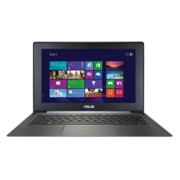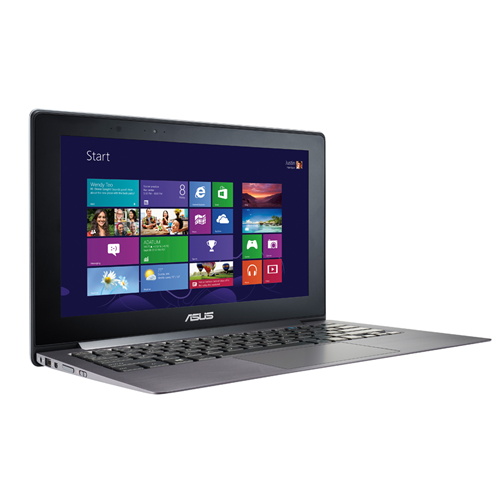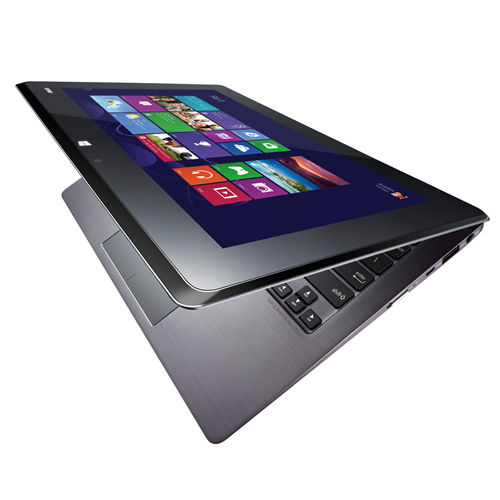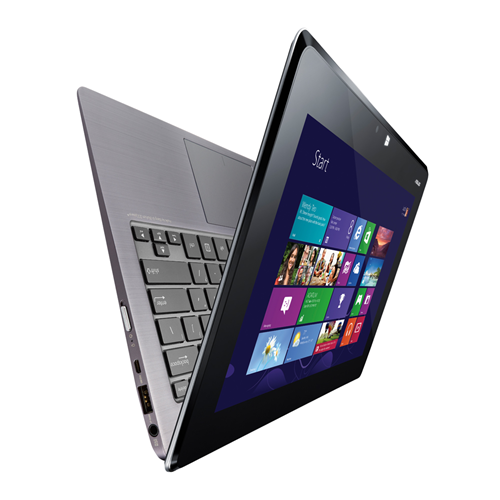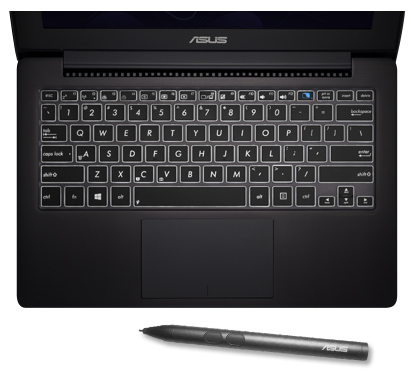Asus Taichi 21-CW002H
Especificaciones de Portátil(es)
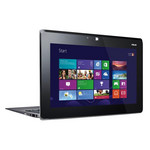
Price comparison
Promedio de 3 puntuaciones (de 6 análisis)
Análisis para el Asus Taichi 21-CW002H
Origen: PC Authority
 EN→ES Archive.org version
EN→ES Archive.org versionMany manufacturers are struggling to find the most natural meeting point between the tablet and the laptop, and Asus’ own Windows 8 range provides yet more evidence of this. With its VivoBooks marrying touchscreens to standard laptops, the forthcoming VivoTab range mimicking the separate tablet and keyboard dock concept of the Android-powered Transformer Pad, and the Taichi 21 ploughing its own dual-screened furrow, it seems even Asus isn’t confident enough to put all of its eggs in one basket. Give it a few years and a refined, lighter chassis married with more power-efficient CPUs and improved battery life could see this dual-screened form factor present a compelling hybrid. At present, though, Asus’ Taichi 21 feels like a bold, innovative concept that’s just a little too far ahead of its time.
Único Análisis, disponible online, corto, Fecha: 02/19/2013
Puntuación: Puntuación total: 67%
Origen: Ultrabook News
 EN→ES Archive.org version
EN→ES Archive.org versionASUS deserves applause for trying something new and doing it as well as is possible given the current technology. It’s a flagship product that’s brought ASUS a lot of well- deserved attention but we don’t think it’s going to sell that well. It’s simply ahead of its time. Ivy Bridge is not a consumer tablet-capable processor and sandwiching two 1080p screens comes with big size and battery life trade-offs. The Taichi 21 needs to be 20% lighter with 50% better battery life. Interestingly that could be only one generation away. Haswell could make products like this into highly dynamic and usable devices that span consumer and business use.
Único Análisis, disponible online, largo, Fecha: 02/11/2013
Origen: Engadget
 EN→ES Archive.org version
EN→ES Archive.org versionAround the time I wrote this review, I was also working on Engadget's first-ever laptop buyer's guide. I was sure the TAICHI would be a shoo-in for the convertible section, what with its innovative design and sterling spec sheet. Unfortunately, as inventive as this is as a concept, the finished product isn't quite what we all thought it would be.
Único Análisis, disponible online, largo, Fecha: 02/06/2013
Origen: Good Gear Guide
 EN→ES Archive.org version
EN→ES Archive.org versionThe ASUS Taichi 21 is a hybrid Ultrabook that ships with two Full HD screens. Open the lid to use it as a laptop, close the lid to use it as a tablet. It's easy to use and it provides a very good tablet experience. It's not perfect though: we think it needs some tweaks to the hardware and software. But overall, it's a unit worth considering if you're after a Windows 8 hybrid unit.
Único Análisis, disponible online, Mediano, Fecha: 11/19/2012
Puntuación: Puntuación total: 75%
Origen: Chip.de
 DE→ES Archive.org version
DE→ES Archive.org versionÚnico Análisis, disponible online, Mediano, Fecha: 02/05/2013
Puntuación: Puntuación total: 78% precio: 63% rendimiento: 75% características: 66% pantalla: 89% movilidad: 71% ergonomía: 88%
Origen: Notebookjournal
 DE→ES Archive.org version
DE→ES Archive.org versionÚnico Análisis, disponible online, largo, Fecha: 01/18/2013
Puntuación: rendimiento: 70% características: 30% pantalla: 70% movilidad: 40% procesamiento: 70% ergonomía: 20%
Comentario
Intel HD Graphics 4000: Tarjeta de video de procesador de gama alta de los modelos Ivy Bridge. Ofrece una frecuencia diferente en los diferentes modelos de CPU (ULV a quad core de desktop) y, por tanto, un rendimiento diferente.
Algunos juegos actuales no fastidiosos pueden ser jugados fluidamente con pequeños detalles.
>> Más información puede ser encontrada en nuestra comparación de tarjetas gráficas moviles y la lista de benchmarks.
3317U: CPU ULV basado en Ivy-Bridge en el segundo trimestre de 2012. Ofrece una frecuencia de 1,7 - 2,6 GHz y un GPU HD 4000 (350 - 1050 MHz). El TDP es de 17 W.
>> Más información puede ser encontrada en nuestra comparación de procesadores móviles.




